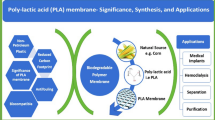Abstract
Penicillin acylase obtained from E. Coli (E. C. 3.5.1.11) was covalently bound via glutaric aldehyde to acrylic carriers crosslinked with divinylbenzene or ethylene glycol dimethacrylate. The best enzymatic preparation was obtained by using ethyl acrylate/ ethylene glycol dimethacrylate copolymer. 1 cm3 of the carrier bound 6.4 mg of protein, having 72% activity in relation to the native enzyme. The preparation lost only 10% of its initial activity after 100 d of storage at 4°C. A negligible effect of immobilization on the enzyme activity at different temperatures or pH as well as significant increase of the stability of the immobilized enzyme at elevated temperatures were observed.
Similar content being viewed by others
Abbreviations
- BA:
-
butyl acrylate
- AE:
-
ethyl acrylate
- PA:
-
penicillin acylase
- 6-APA:
-
6-aminopenicillanic acid
- EGDMA:
-
ethylene glycol dimethacrylate
- DVB:
-
divinylbenzene
References
Marconi, W.; Cecere, F.; Morisi, F.; Della-Penna, G.; Rappouli, B.: The hydrolisis of penicillin G to 6-aminopenicillanic acid by entrapped penicillin acylase. J. Antibiotics 24 (1973) 228–232
Lagerlöf, E.; Narthorst-Westfelt, L.; Ekström, B.; Sjöberg, B.: Production of 6-aminopenicillanic acid with immobilized Escherichia coli acylase. Methods in Enzymology 44 (1975) 759–767
Abbot, B. J.: Preparation of pharmaceutical compounds by immobilized enzyme and cells. Adv. Appl. Microbiol. 20 (1976) 203–257
Self, D. A.; Kay, G.; Lilly, M. D.; Dunnill, P.: The conversion of benzyl penicillin to 6-aminopenicillanic acid using an insoluble derivative of penicillin amidase. Biotechnol. Bioeng. 11 (1969) 337–348
Jung, E.; Schirdewahn, J.: Germ. Patent 2336829, 1974
Carleysmith, S. W.; Dunnill, P.; Lilly, M. D.: Kinetic behavior of immobilized penicillin acylase Biotechnol. Bioeng. 22 (1980) 735–756
Kolarz, B. N.; Łobarzewski, J.; Szewczuk, A.; Rapak, A.; Trochimczuk, A.; Wojaczyńska, M.: Polish Patent Appl. P-251505, 1986
Kolarz, B. N.; Wojaczyńska, M.; Hermann, B.; Polyacrylamide sorbents. Synthesis and properties. Reactive Polym. (in press)
Lowry, O. H.; Rosebrough, N. J.; Farr, N. J.; Randall, R. J.; Protein measurement with the foulin phenol reagent. J. Biol. Chem. 193 (1951) 265–275
Balasingham, K.; Warburton, D.; Dunnill, P.; Lilly, D. M.: The isolation and kinetics of penicillin amidase from Escherichia coli. Biochim. Biophys. Acta 276 (1972) 250–256
Yon, R. J.: Wheat-germ aspartate transcarboamylase. Effects of ligands on the inactivation of the enzyme by trypsin and denaturing agnets. Biochem. J. 131 (1973) 699–706
Chibata, I.: Immobilized enzymes, pp. 9–107. New York: Wiley & Sons 1979
Trevan, M. D.: Immobilized enzymes. Chichester: Wiley & Sons 1980
Bryjak, J.; Noworyta, A.; Polanowski, A.; Mozol, G.: Immobilization of trypsin on polymer carriers, pp. 155–160. In: Conference Materials Postepy inzynierii bioreaktorowej. 10–11 Dec. 1987, Łódź
Savidge, T. A.; Cole, M.: Penicillin acylase bacterial. Methods in Enzymology 43 (1975) 705–721
Klimanov, A. M.: Immobilized enzymes and cells as practical catalysts. Science 219 (1983) 722–727
Author information
Authors and Affiliations
Rights and permissions
About this article
Cite this article
Bryjak, J., Trochimczuk, A. & Noworyta, A. Immobilization of penicillin acylase on acrylic carriers. Bioprocess Eng. 4, 159–162 (1989). https://doi.org/10.1007/BF00369394
Received:
Issue Date:
DOI: https://doi.org/10.1007/BF00369394




